Heuristic-Based Journey Planner for Mobility as a Service (MaaS)
Abstract
1. Introduction
2. Literature Review
- -
- Graph-based algorithms involve a computationally expensive pre-processing stage which cannot take into account real-time information unless it can be reasonably implemented on the fly. Therefore, many dynamic (floating car-sharing) and on-demand (ride-hailing with different ETAs based on location) services included in MaaS cannot be easily integrated.
- -
- Existing approaches lack flexibility in applying soft or hard constraints dynamically. As MaaS requires the generation of routes that can be realised based on the user’s subscription plan or the characteristics of a particular service, this is an important requirement. Soft constraints may be related to user preferences and as these increase, so does the computational intensity of embedding them into cost functions for a graph.
- -
- The integration of new requirements may necessitate significant alternations to an algorithm’s operation. For example, a requirement that was identified as part of the MaaS4EU project was the redirection of a user through a ticket collection location prior to boarding a public transport service. Although this can be encoded as a waypoint in existing techniques, it is unknown how the modes assigned to the journey’s segments before and after the waypoint may be applicable to this requirement.
3. Methodology
3.1. Journey Planning Approach
- Bike sharing (MOL Bubi [52]): a data endpoint that provides information for bike sharing stations including location, available and booked bikes, free racks, station name, etc.
- Car sharing (GreenGo [53]): data related to available vehicles of an electric car sharing fleet including vehicle location, range, license plate number, make, model, etc.
- Ride sharing (Motar [56]): an API that provides available rides between an origin and destination city/location with information about the cost of the trip, travel/departure/arrival times, availability of spaces in the vehicle, as well as qualitative information about the driver such as user scoring.
- Parking spaces: a database interface that allows the collection of information regarding parking spaces that can be used as part of Park and Ride (P&R) trips.
- walking distances from/to public transport stops and the closest bike-sharing station, car-sharing vehicle and parking station
- driving distances from origin/to destination for each public transport stop
- walking distances from origin/to destination for each bike-sharing station
- walking distances from origin/to destination for each car-sharing vehicle
3.2. Scenario-Based Heuristic
- Lines 1–4, load all the data necessary for the realisation of the scenario. Such data may include unimodal routes, user profiles, mobility services availability, etc., and have been retrieved before the running of the scenario. Following this, the locations of public transport stops and bike stations that can be utilised as part of the scenario are identified (Figure 5a).
- Line 5, applies a hard-constraint based on the profile of the user, which stipulates that the walking distance from the origin to the closest bike station should be within limits set in the user’s profile. If the constraint is not met, the scenario execution is aborted without returning any routes.
- Lines 6–8, utilise existing or generate new isochrones based on the locations of the public transport stops and bike stations to potentially be included in the routes. Walking distances between each public transport stop and its closest bike station (Figure 5b) and cycling distances and times between all bike stations (Figure 5c) are derived.
- Line 9, defines all the possible bike-sharing legs in a simplified form and with information related to the origins, destinations, distances and travel times.
- Lines 10–14, derive the valid bike-sharing legs based on constraints set by user preferences. These include the walking distance from the alighting public transport stop to the bike station and the cycling distance of the leg (Figure 5d).
- Lines 15–19, construct partial routes composed of public transport and bike sharing legs. This involves substitution of parts of the original public transport route with a bike-sharing leg. All the information required for the application of TOPSIS Multi-Attribute Decision-Making (MADM) is included in the partial route.
- Lines 20–26, rank the constructed partial routes using a set of criteria with scores and weights based on empirical investigations with experts participating in the MaaS4EU project. This was achieved by a preliminary evaluation round using the web application shown in Figure 3. Experts were asked in their professional capacity to rate the level of acceptability of each route (Figure 6) and rank the presented routes in the order of preference (Figure 7). For this particular scenario, the details for the application of TOPSIS can be seen in Table 3.
- Lines 27–30, the top-ranked sub-routes are populated with additional legs for constructing the completed route. Such legs may be ‘action’ ones for picking-up and dropping-off the bike and walking legs for (a) the transition from public transport to bike-sharing and (b) from the last bike sharing station to the destination.
3.3. Route Recommender
- For users without a driving license, routes with modes that require driving are excluded.
- Routes with long bicycle distances (as defined by the user) are excluded.
- Routes with long walking distances (as defined by the user) are excluded.
- Routes with services for which a user does not have any allowances left (i.e., minutes left for car sharing service).
- Based on the users’ past behaviour, which are calculated using as input past choices the user has made in the period following the subscription to a MaaS plan and the inferred behaviour as it is logged through the usage of the subscribed MaaS plan. These context variables include: increased car-sharing usage trend; increased bike-sharing usage trend; increased taxi usage trend; increased ride-sharing usage trend.
- Based on trip characteristics, which can be calculated using as input the available routes. These context variables are activated on a per route basis and include the walking distance and the bike distance.
- Based on combination of users’ past behaviour and trip characteristics, which can be calculated using as input both past choices the user has made in the period following the subscription to a MaaS plan as well as the available routes.
- Based on environmental information. In this case, we make use of information about the environment in which the route recommendation takes place. We define the variable “Nice Weather” which refers to the current status of the weather and is set to True when the temperature level exceeds a certain configurable threshold, and the precipitation level is below another configurable threshold.
- Based on a combination of environmental information and trip characteristics. We make use of information about both the business environment in which the route recommendation takes place and the available routes.
4. Implementation
5. User Acceptance Evaluation
- (i).
- A star rating (from 1–5) evaluation for the group of recommended routes for a particular routing request (Figure 11)
- (ii).
- A star rating (from 1–5) for a single route, which was available to the user after selecting one of the recommended routes (Figure 12)
- (iii).
- A notification service which presented questions with Likert-scale response options for evaluating different properties of the presented routes (for example, fit-for-purpose based on user needs, quality of the route ranking and others, Figure 13).
5.1. Star Rating Evaluation
5.2. Notifications-Based Evaluation
- [Q1] The routes that are being presented to me cover my needs.
- [Q2] The routes that are being presented to me contain a good mix of all available modes in my MaaS4EU plan.
- [Q3] The order of the routes that are being presented to me matches my travel preferences.
- [Q4] The route ranking affected my travel decisions.
6. Conclusions
- The dynamic generation of scenarios on-the-fly and based on service availability, trip purpose, user profile and other parameters. Such scenarios may include multiple services and may be constructed by the integration of existing base scenarios. For example, the combination of driving-public transport (P&R) and public transport-bike sharing scenarios may result in a route that integrates driving, public transport and bike sharing.
- The formulation of additional heuristics to limit the need for multiple ranking/filtering rounds that may require calls to external APIs, thus negatively affecting computational times. This may involve reuse of past routes with similar characteristics (i.e., origin, destination, time of day, etc.) and utilisation of predictive analytics for approximating the condition of services based on historical data.
- The dynamic calibration of the utility functions and optimisation attributes based on user feedback. This can be achieved by applying machine learning algorithms which can be trained based on the stated preferences of users regarding different routes.
- The integration of the proposed solution in simulation models for assessing the impact of MaaS in urban areas based on what-if scenarios [69]. Such scenarios may describe different fleet compositions, variable locations for vehicle/bike stations, various penetration rates of services and other.
- Finally, it is believed that a more disaggregated evaluation of users’ perceptions will lead to a better understanding of their expectations regarding a planning solution for MaaS.
Author Contributions
Funding
Acknowledgments
Conflicts of Interest
References
- Urbanization. Available online: https://ourworldindata.org/urbanization (accessed on 24 October 2020).
- Kamargianni, M.; Li, W.; Matyas, M.; Sch Afer, A. A critical review of new mobility services for urban transport. Transp. Res. Procedia 2016, 14, 3294–3303. [Google Scholar] [CrossRef]
- Lyons, G.; Hammond, P.; Mackay, K. The importance of user perspective in the evolution of MaaS. Transp. Res. Part A Policy Pract. 2019, 121, 22–36. [Google Scholar] [CrossRef]
- Fioreze, T.; de Gruijter, M.; Geurs, K. On the likelihood of using mobility-as-a-service: A case study on innovative mobility services among residents in the Netherlands. Case Stud. Transp. Policy 2019, 7, 790–801. [Google Scholar] [CrossRef]
- Alonso-González, M.J.; Hoogendoorn-Lanser, S.; van Oort, N.; Cats, O.; Hoogendoorn, S. Drivers and barriers in adopting mobility as a service (MaaS)—A latent class cluster analysis of attitudes. Transp. Res. Part A Policy Pract. 2020, 132, 378–401. [Google Scholar] [CrossRef]
- Ho, C.Q.; Hensher, D.A.; Mulley, C.; Wong, Y.Z. Potential uptake and willingness-to-pay for mobility as a service (MaaS): A stated choice study. Transp. Res. Part A Policy Pract. 2018, 117, 302–318. [Google Scholar] [CrossRef]
- Cruz, C.O.; Sarmento, J.M. “Mobility as a Service” Platforms: A critical path towards Increasing the sustainability of transportation systems. Sustainability 2020, 12, 6368. [Google Scholar] [CrossRef]
- Schikofsky, J.; Dannewald, T.; Kowald, M. Exploring motivational mechanisms behind the intention to adopt mobility as a service (MaaS): Insights from Germany. Transp. Res. Part A Policy Pract. 2020, 131, 296–312. [Google Scholar] [CrossRef]
- Mola, L.; Berger, Q.; Haavisto, K.; Soscia, I. Mobility as a service: An exploratory study of consumer mobility behaviour. Sustainability 2020, 12, 8210. [Google Scholar] [CrossRef]
- Reyes Garcia, J.R.; Lenz, G.; Haveman, S.P.; Bonnema, G.M. State of the art of mobility as a service (MaaS) ecosystems and architectures: An overview of, and a definition, ecosystem and system architecture for electric mobility as a service (eMaaS). World Electr. Veh. J. 2019, 11, 7. [Google Scholar] [CrossRef]
- Polydoropoulou, A.; Pagoni, I.; Tsirimpa, A.; Roumboutsos, A.; Kamargianni, M.; Tsouros, I. Prototype business models for mobility-as-a-service. Transp. Res. Part A Policy Pract. 2020, 131, 149–162. [Google Scholar] [CrossRef]
- Vaddadi, B.; Zhao, X.; Susilo, Y.; Pernestål, A. Measuring system-level impacts of corporate mobility as a service (CMaaS) based on empirical evidence. Sustainability 2020, 12, 7051. [Google Scholar] [CrossRef]
- Karlsson, I.C.M.; Mukhtar-Landgren, D.; Smith, G.; Koglin, T.; Kronsell, A.; Lund, E.; Sarasini, S.; Sochor, J. Development and implementation of mobility-as-a-service—A qualitative study of barriers and enabling factors. Transp. Res. Part A Policy Pract. 2020, 131, 283–295. [Google Scholar] [CrossRef]
- Matyas, M. Opportunities and barriers to multimodal cities: Lessons learned from in-depth interviews about attitudes towards mobility as a service. Eur. Transp. Res. Rev. 2020, 12. [Google Scholar] [CrossRef]
- Wu, J.; Zhou, L.; Cai, C.; Shen, J.; Lau, S.K.; Yong, J. Data fusion for MaaS: Opportunities and challenges. CSCWD 2018, 642–647. [Google Scholar] [CrossRef]
- Harrison, G.; Gühnemann, A.; Shepherd, S. The business case for a journey planning and ticketing app-Comparison between a simulation analysis and real-world data. Sustainability 2020, 12, 4005. [Google Scholar] [CrossRef]
- Keller, A.; Aguilar, A.; Hanss, D. Car sharers’ interest in integrated multimodal mobility platforms: A diffusion of innovations perspective. Sustainability 2018, 10, 4689. [Google Scholar] [CrossRef]
- MaaS4EU—End-to-End Approach for Mobility-as-a-Service Tools, Business Models, Enabling Framework and Evidence for European Seamless Mobility, H2020 Project. Available online: http://www.maas4eu.eu/ (accessed on 18 November 2020).
- Ştefănescu, P.; Mocan, M.; Ştefănescu, W.; Neculai, P.V. Trip planners used in public transportation. Case study on the city of Timişoara. Procedia Soc. Behav. Sci. 2014, 124, 142–148. [Google Scholar] [CrossRef][Green Version]
- Rahaman, M.S.; Mei, Y.; Hamilton, M.; Salim, F.D. CAPRA: A contour-based accessible path routing algorithm. Inf. Sci. 2017, 385–386, 157–173. [Google Scholar] [CrossRef]
- Dijkstra, E.W. A note on two problems in connexion with graphs. Numerische Mathematik 1959, 1, 269–271. [Google Scholar] [CrossRef]
- Hart, P.E.; Nilsson, N.J.; Raphael, B. A Formal Basis for the Heuristic Determination of Minimum Cost Paths. IEEE Trans. Syst. Sci. Cybernet. 1968, 4, 100–107. [Google Scholar] [CrossRef]
- Geisberger, R.; Sanders, P.; Schultes, D.; Delling, D. Contraction Hierarchies: Faster and Simpler Hierarchical Routing in Road Networks, Experimental, Algorithms; McGeoch, C.C., Ed.; Springer: Berlin/Heidelberg, Germany, 2008; pp. 319–333. [Google Scholar]
- Schulz, F.; Wagner, D.; Weihe, K. Dijkstra’s algorithm on-line: An empirical case study from public railroad transport. ACM J. Exp. Algorithms 2000, 5, 12. [Google Scholar] [CrossRef]
- Stølting Brodal, G.; Jacob, R. Time-dependent networks as models to achieve fast exact time-table queries. Electr. Notes Theor. Comput. Sci. 2004, 92, 3–15. [Google Scholar] [CrossRef]
- Delling, D.; Pajor, T.; Werneck, R.F. Round-based public transit routing. Transp. Sci. 2015, 49, 591–604. [Google Scholar] [CrossRef]
- Delling, D.; Dibbelt, J.; Pajor, T. Fast and exact public transit routing with restricted pareto sets. In Proceedings of the Meeting on Algorithm Engineering and Experiments (ALENEX), San Diego, CA, USA, 7–8 January 2019. [Google Scholar]
- Witt, S. Trip-Based Public Transit Routing Using Condensed Search Trees, Schloss Dagstuhl-Leibniz-Zentrum fur Informatik; Dagstuhl Publishing: Wadern, Germany, 2016; pp. 1–12. [Google Scholar]
- Wang, Y.; Yuan, Y.; Ma, Y.; Wang, G. Time-dependent graphs: Definitions, applications, and algorithms. Data Sci. Eng. 2019, 4, 352–366. [Google Scholar] [CrossRef]
- Bast, H.; Delling, D.; Goldberg, A.; Müller-Hannemann, M.; Pajor, T.; Sanders, P.; Wagner, D.; Werneck, R.F. Route planning in transportation networks. In Lecture Notes in Computer Science (Including Subseries Lecture Notes in Artificial Intelligence and Lecture Notes in Bioinformatics); Springer: Cham, Switzerland, 2016; Volume 9220, pp. 19–80. [Google Scholar]
- Casey, B.; Bhaskar, A.; Guo, H.; Chung, E. Critical review of time-dependent shortest path algorithms: A multimodal trip planner perspective. Trans. Rev. 2014, 34, 522–539. [Google Scholar] [CrossRef][Green Version]
- Giannakopoulou, K.; Paraskevopoulos, A.; Zaroliagis, C. Multimodal dynamic journey-planning. Algorithms 2019, 12, 213. [Google Scholar] [CrossRef]
- Zhu, S.; Wang, Y.; Shang, S.; Zhao, G.; Wang, J. Probabilistic routing using multimodal data. Neurocomputing 2017, 253, 49–55. [Google Scholar] [CrossRef]
- Yu, G.; Yang, Y. Dynamic routing with real-time traffic information. Oper. Res. 2017, 1–26. [Google Scholar] [CrossRef]
- Liebig, T.; Piatkowski, N.; Bockermann, C.; Morik, K. Dynamic route planning with real-time traffic predictions. Inf. Syst. 2017, 64, 258–265. [Google Scholar] [CrossRef]
- He, Y.; Csiszár, C. Concept of mobile application for mobility as a service based on autonomous vehicles. Sustainability 2020, 12, 6737. [Google Scholar] [CrossRef]
- Ghaderi, F.; Pahlavani, P. A new multimodal multi-criteria route planning model by integrating a fuzzy-AHP weighting method and a simulated annealing algorithm. ISPRS Int. Arch. Photogram. Remote Sens. Spat. Inf. Sci. 2015. [Google Scholar] [CrossRef]
- Bucher, D.; Jonietz, D.; Raubal, M. A Heuristic for multi-modal route planning. In Progress in Location-Based Services 2016. Lecture Notes in Geoinformation and Cartography; Gartner, G., Huang, H., Eds.; Springer: Cham, Switzerland, 2017. [Google Scholar]
- Yu, H.; Lu, F. A multi-modal route planning approach with an improved genetic algorithm. Int. Arch. Photogram. Remote Sens. Spat. Inf. Sci. 2012, 38, 344–348. [Google Scholar]
- Eiter, T.; Krennwallner, T.; Prandtstetter, M.; Rudloff, C.; Schneider, P.; Straub, M. Semantically enriched multi-modal routing. Int. J. Intell. Transp. Syst. Res. 2016, 14. [Google Scholar] [CrossRef]
- Prandtstetter, M.; Straub, M.; Puchinger, J. On the way to a multi-modal energy-efficient route. In Proceedings of the IECON 2013—39th Annual Conference of the IEEE Industrial Electronics Society, Vienna, Austria, 10–13 November 2013; pp. 4779–4784. [Google Scholar]
- Georgakis, P.; Almohammad, A.; Bothos, E.; Magoutas, B.; Arnaoutaki, K.; Mentzas, G. MultiModal route planning in mobility as a service. In Proceedings of the 2019 IEEE/WIC/ACM International Conference on Web Intelligence (WI 2019), Thessaloniki, Greece, 14–17 October 2019; Volume 2019, pp. 283–291. [Google Scholar]
- Google Directions API. Available online: https://developers.google.com/maps/documentation/directions/start (accessed on 18 November 2020).
- Bing Maps Routes. API. Available online: https://docs.microsoft.com/en-us/bingmaps/rest-services/routes/ (accessed on 18 November 2020).
- HERE Routing. Available online: https://developer.here.com/documentation/routing/dev_guide/topics/resources.html (accessed on 18 November 2020).
- Open Source Routing Machine. Available online: http://project-osrm.org/ (accessed on 18 November 2020).
- Open Trip Planning. Available online: https://www.opentripplanner.org/ (accessed on 18 November 2020).
- Hamurcu, M.; Eren, T. An application of multicriteria decision-making for the evaluation of alternative monorail routes. Mathematics 2018, 7, 16. [Google Scholar] [CrossRef]
- Güner, S. Measuring the quality of public transportation systems and ranking the bus transit routes using multi-criteria decision making techniques. Case Stud. Trans. Policy 2018, 6, 214–224. [Google Scholar] [CrossRef]
- Shih, H.; Shyur, H.; Lee, E.S. An extension of TOPSIS for group decision making. Math. Comput. Model. 2007, 45, 801–813. [Google Scholar] [CrossRef]
- Daniels, R.; Mulley, C. Explaining walking distance to public transport: The dominance of public transport supply. J. Trans. Land Use 2013, 6, 5–20. [Google Scholar] [CrossRef]
- MOL Bubi. Bike Sharing. Available online: https://molbubi.hu (accessed on 18 November 2020).
- GreenGo. Car Sharing. Available online: https://greengo.com (accessed on 18 November 2020).
- City Taxi. Ride Hailing. Available online: https://www.citytaxi.hu (accessed on 18 November 2020).
- Uber. Ride Hailing. Available online: https://developer.uber.com (accessed on 18 November 2020).
- Motar. Ride Sharing. Available online: https://www.motar.eu (accessed on 18 November 2020).
- Manley, E.J.; Orr, S.W.; Cheng, T. A heuristic model of bounded route choice in urban areas. Transp. Res. Part C Emerg. Technol. 2015, 56, 195–209. [Google Scholar] [CrossRef]
- HERE Public Transit API. Available online: https://developer.here.com/documentation/public-transit/dev_guide/index.html (accessed on 18 November 2020).
- OpenMobilityData. Available online: https://transitfeeds.com/ (accessed on 18 November 2020).
- Lamsfus, C.; Wang, D.; Alzua-Sorzabal, A.; Xiang, Z. Going mobile: Defining context for on-the-go travelers. J. Travel Res. 2015, 54, 691–701. [Google Scholar] [CrossRef]
- Ulrike, G.; Hwang, Y.-H.; Fesenmaier, D.R. Informing destination recommender systems design and evaluation through quantitative research. Int. J. Cult. Tour. Hosp. Res. 2012, 6, 297–315. [Google Scholar] [CrossRef]
- Anagnostopoulou, E.; Urbančič, J.; Bothos, E.; Magoutas, B.; Bradesko, L.; Schrammel, J.; Mentzas, G. From mobility patterns to behavioural change: Leveraging travel behaviour and personality profiles to nudge for sustainable transportation. J. Intell. Inf. Syst. 2020, 54, 157–178. [Google Scholar] [CrossRef]
- Brazil, W.; Caulfield, B.; Bothos, E. Transport emissions information: Lessons from the PEACOX project. In Proceedings of the Irish Transport Research Network (ITRN), Dublin, Ireland, 27–28 August 2015. [Google Scholar]
- Benediktsson, J.A.; Kanellopoulos, I. Classification of multisource and hyperspectral data based on decision fusion. IEEE Trans. Geosci. Remote Sens. 1999, 37, 1367–1377. [Google Scholar] [CrossRef]
- Moleculer–Progressive Microservices Framework for Node.js. Available online: https://moleculer.services/ (accessed on 18 November 2020).
- Melis, A.; Mirri, S.; Prandi, C.; Prandini, M.; Salomoni, P.; Callegati, F. Integrating personalized and accessible itineraries in MaaS ecosystems through microservices. Mob. Netw. Appl. 2018, 23, 167–176. [Google Scholar] [CrossRef]
- TOPSIS–npm Package. Available online: https://www.npmjs.com/package/topsis (accessed on 18 November 2020).
- Redis–In-Memory Data Structure Store. Available online: https://redis.io/ (accessed on 18 November 2020).
- Kostrzewski, M. Implementation of distribution model of an international company with use of simulation method. Procedia Eng. 2017, 192, 445–450. [Google Scholar] [CrossRef]
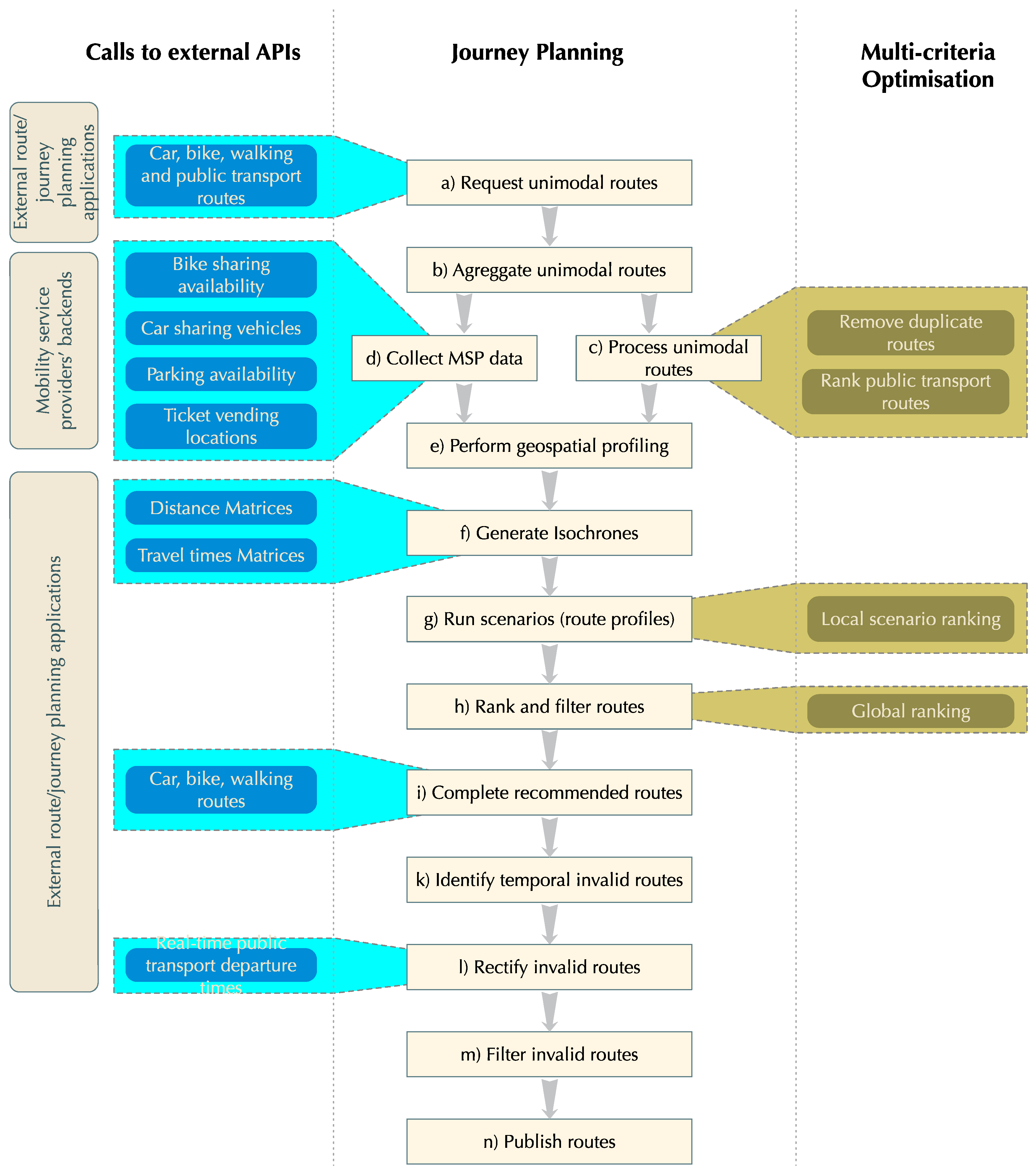
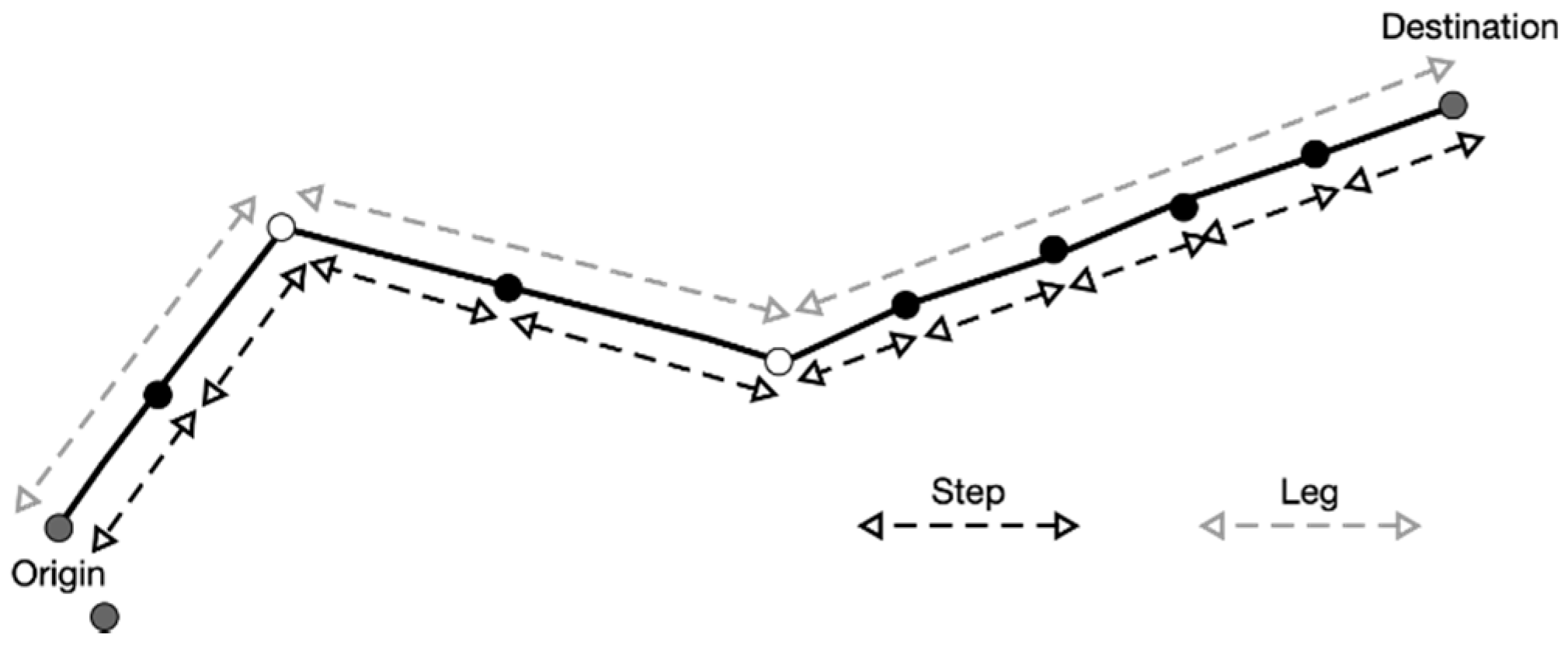

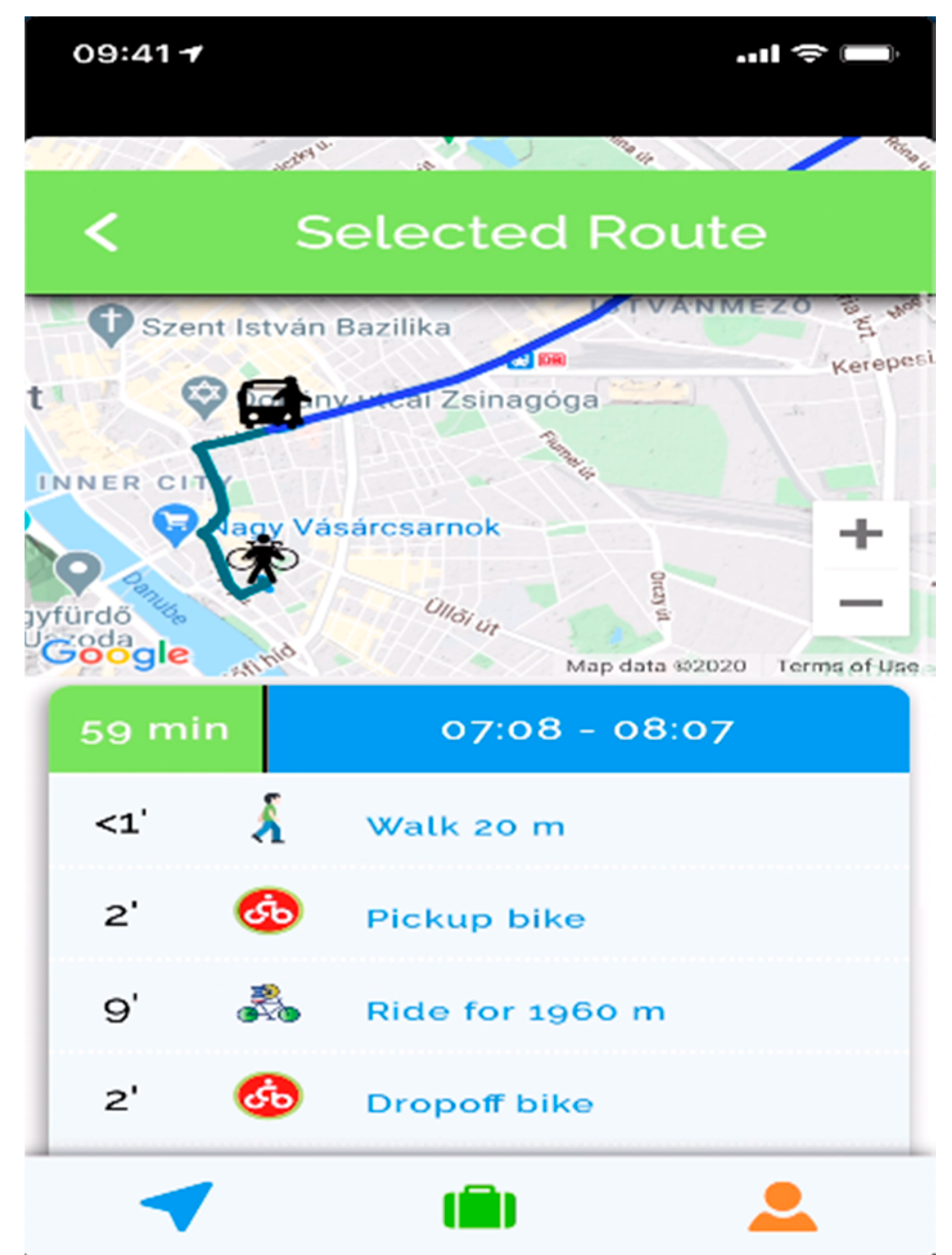

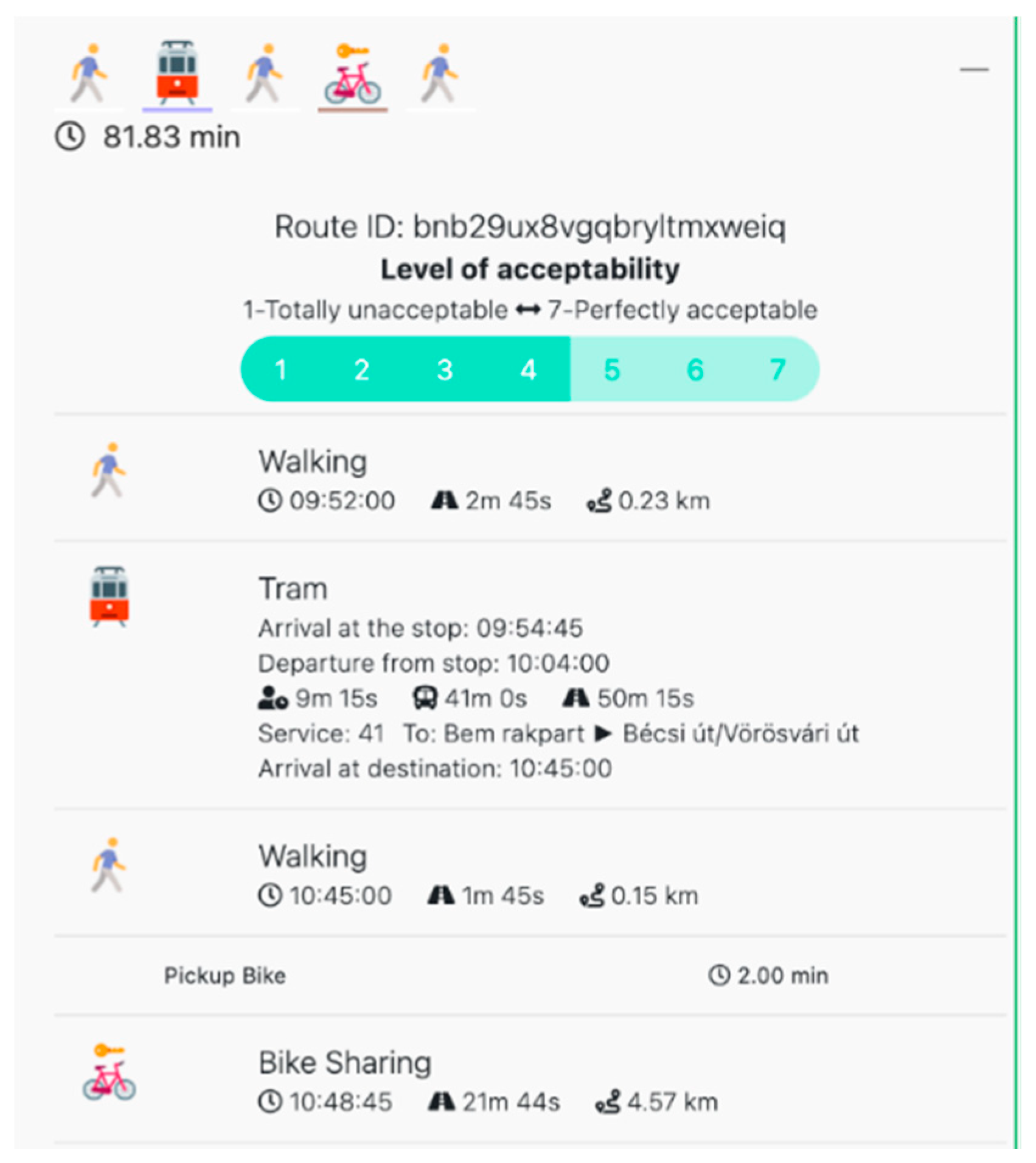
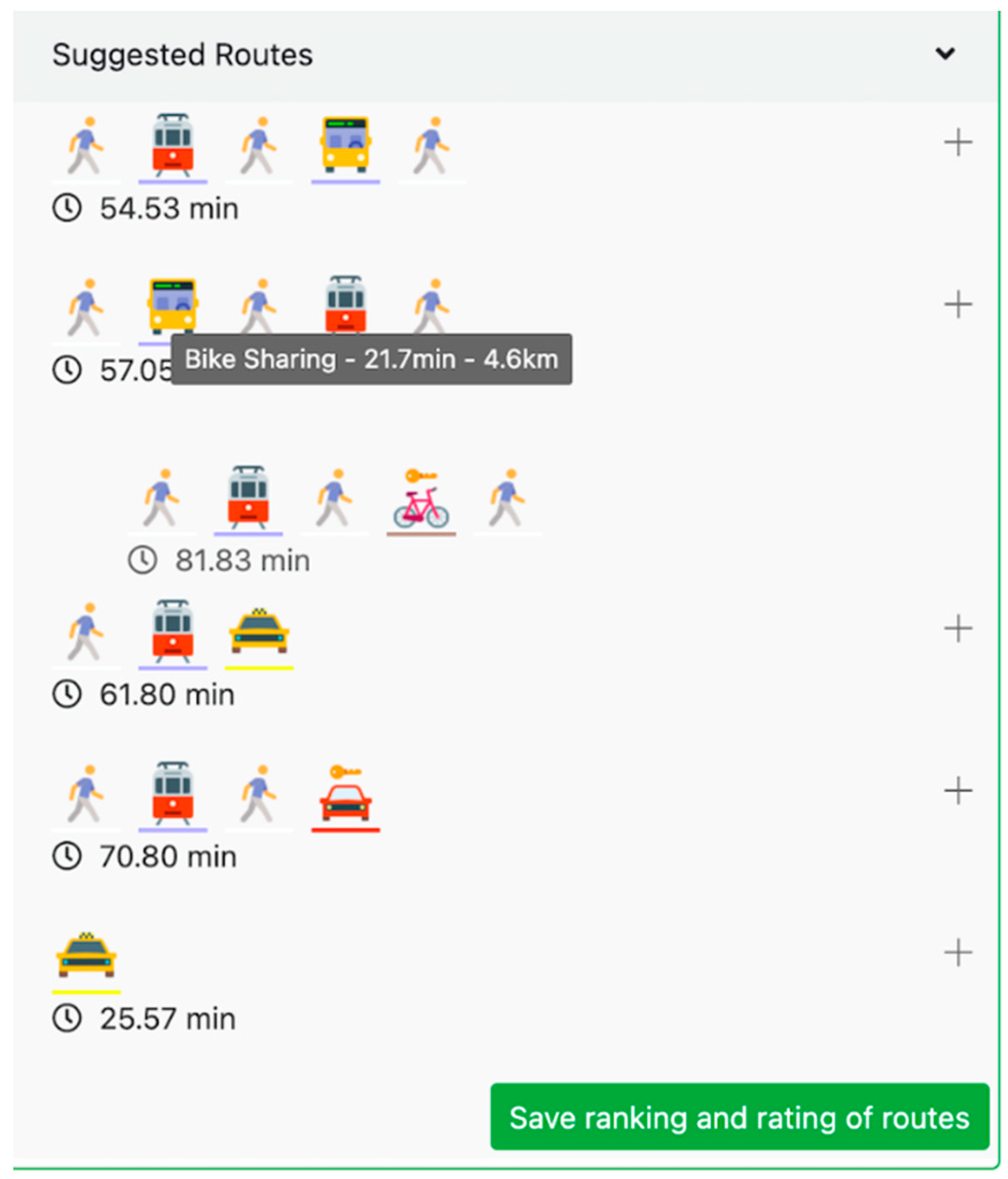


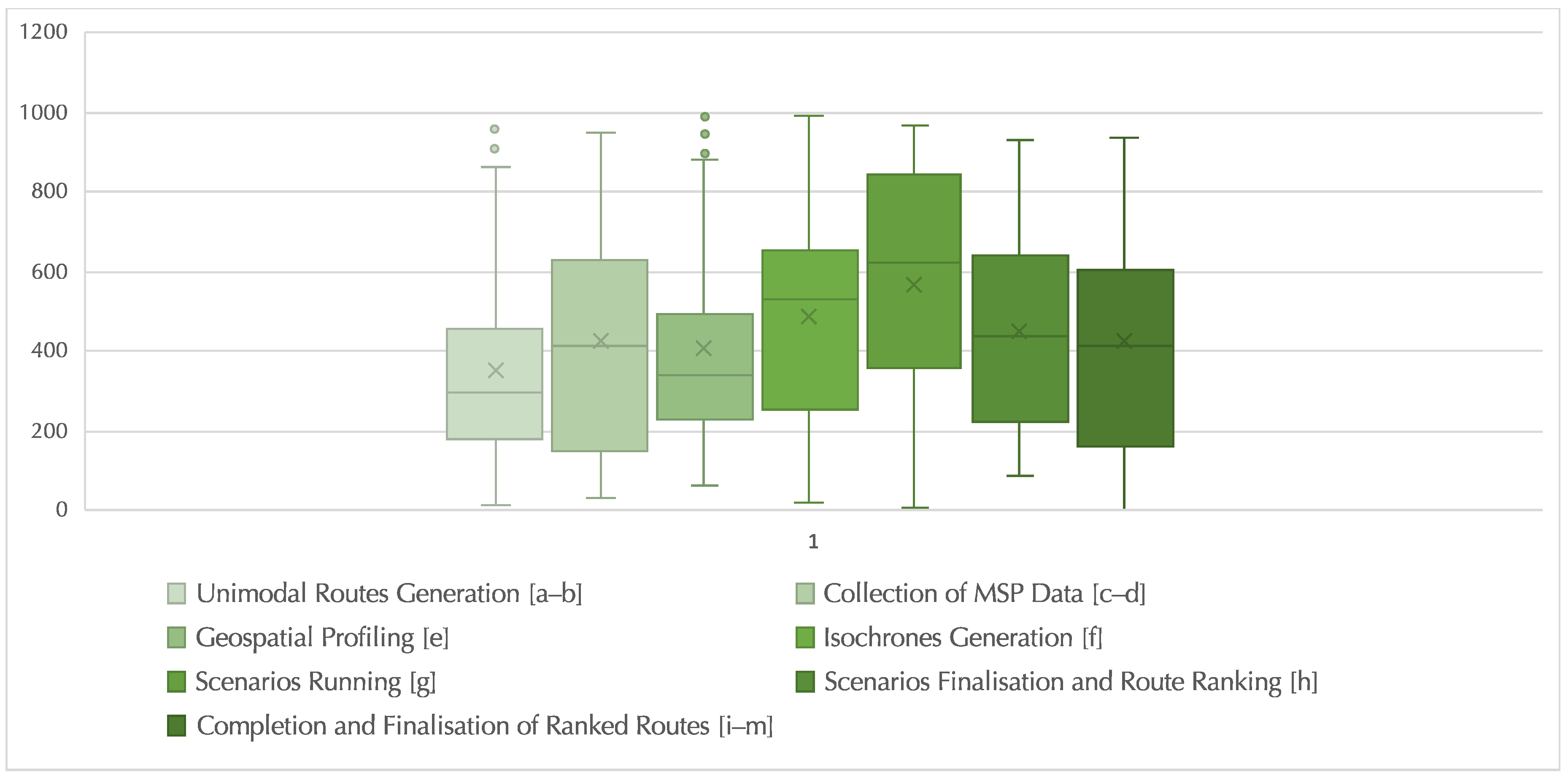






| Scenario (Modes Order as in the Route) | Use Case | Conditions and Properties |
|---|---|---|
| (1) Bike-sharing from origin to destination | Short distance urban trips with active travelling | Bike stations within walking distance from origin/destination, cycling leg distance matching user preferences, cycling leg travel time within service limit duration set by the provider. |
| (2a) Bike-sharing to public transport 1 (2b) Public transport to bike sharing | Trips where the destination scenario 2a/origin2b are far away from a bike station and active travelling is favourable | Bike station within walking distance from the origin2a/destination2b, cycling leg distance matching user preferences, cycling leg travel time within service limit duration set by the provider. |
| (3) Car-sharing from origin to destination | Medium distance urban trips without active travelling | Origin and destination within the boundaries of the operating area of the service. A vehicle must be present within walking distance from the origin |
| (3a) Car-sharing to public transport (3b) Public transport to car-sharing | Medium to long distance urban trips with origin3b/destination3a outside the operating area of the car-sharing service. Facilitation of first/last mile inner city travelling with car sharing. | Origin3a/destination3b within the boundaries of the operating area of the service. A vehicle must be present within walking distance from the origin3a |
| (4) Ride-hailing from origin to destination | Medium to long distance urban trips | Ride-hailing distance to exceed the minimum distance set by the service provider |
| (5a) Ride-hailing to public transport (5b) Public transport to ride hailing | Medium to long distance urban trips that limit the use of ride hailing. Facilitate first5b/last5a mile inner city travelling with public transport. | Ride-hailing distance to exceed the minimum distance set by the service provider |
| 1 | READ user profile FROM cache |
| 2 | READ unimodal routes FROM cache |
| 3 | READ bike sharing data FROM cache |
| 4 | READ public transport stops data FRON cache |
| 5 | IF closest bike station to destination distance < user preferred walking distance THEN |
| 6 | validBikes ← findBikesCloseToStops (publicTransportStops, bikeSharing) |
| 7 | walkingDistances ← findWalkingDistances (publicTransportStops, validBikes) |
| 8 | cyclingDistances ← findCyclingDistances (validBikeStations) |
| 9 | bikeSharingLegs ← defineBikeSharingLegs (validBikeStations, cyclingDistances) |
| 10 | validBikeSharingLegs ← Empty Array |
| 11 | FOR EACH bikeSharingLeg IN bikeSharingLegs |
| 12 | IF (cycling distance of leg < user preferred cycling distance) AND (walking distance between public transport stop and pick-up bike location < user preferred walking distance) |
| 13 | THEN |
| 14 | add bikeSharingLeg to validBikeSharingLegs |
| 15 | partialBikeSharingRoutes ← Empty Array |
| 16 | FOR EACH bikeSharingLeg IN validBikeSharingLegs |
| 17 | partialPublicTransportRoute ← findPartialPTRoute(unimodalRoutes, bikeSharingLeg) |
| 18 | partialBikeSharingRoutes ← appendLegs(partialPublicTransportRoute, bikeSharingLeg) |
| 19 | mcdaOptions ← loadOptions(criteria, weights, criteriaTypes) |
| 20 | criteriaScoresOfAlternatives ← Empty Array |
| 21 | FOR EACH partialBikeSharingRoute IN partialBikeSharingRoutes |
| 22 | criteriaScoresOfAlternative ← scoreRoute(partialBikeSharingRoute) |
| 23 | add criteriaScoresOfAlternative to criteriaScoresOfAlternatives |
| 24 | add criteriaScoresOfAlternatives to mcdaOptions |
| 25 | rankedPartialBikeSharingRoutes ← runMCDA(mcdaOptions) |
| 26 | incompleteScenarioRoutes ← Empty Array |
| 27 | FOR EACH rankedPartialBikeSharingRoute IN rankedPartialBikeSharingRoutes |
| 28 | incompleteScenarioRoute ← constructRoute(rankedPartialBikeSharingRoute) |
| 29 | add incompleteScenarioRoute to incompleteScenarioRoutes |
| 30 | RETURN incompleteScenarioRoutes |
| RETURN Empty Array |
| Ranking Criteria | Weights | Description | Scoring |
|---|---|---|---|
| Cycling Distance [min] 1 | 0.3 | The degree of similarity of the distance of the bike sharing leg with the user’s preferred cycling distance | where: is the user’s preferred cycling distance, is the distance of the bike sharing leg |
| Cycling/overall route distance ratio [min] | 0.3 | The appropriateness of the ratio of the cycling distance over to the overall distance of the route. An optimal value of 0.5 has been used. This is to avoid routes that have a very short public transport segment compared to that of bike sharing | where: is the optimal ration, is the total cycling distance in the route, is the distance of the bike sharing leg |
| Public transport modal changes [min] | 0.15 | The number of public transport modes used to reach the bike pick-up location | where: l is the number of legs that precede the bike sharing segment of the route |
| Public transport modal speed [max] | 0.25 | The average speed (in qualitative manner 2) of the public transport modes used prior to the bike sharing leg | where: l is the number of legs that precede the bike sharing segment of the route, u is the qualitative speed of the mode |
Publisher’s Note: MDPI stays neutral with regard to jurisdictional claims in published maps and institutional affiliations. |
© 2020 by the authors. Licensee MDPI, Basel, Switzerland. This article is an open access article distributed under the terms and conditions of the Creative Commons Attribution (CC BY) license (http://creativecommons.org/licenses/by/4.0/).
Share and Cite
Georgakis, P.; Almohammad, A.; Bothos, E.; Magoutas, B.; Arnaoutaki, K.; Mentzas, G. Heuristic-Based Journey Planner for Mobility as a Service (MaaS). Sustainability 2020, 12, 10140. https://doi.org/10.3390/su122310140
Georgakis P, Almohammad A, Bothos E, Magoutas B, Arnaoutaki K, Mentzas G. Heuristic-Based Journey Planner for Mobility as a Service (MaaS). Sustainability. 2020; 12(23):10140. https://doi.org/10.3390/su122310140
Chicago/Turabian StyleGeorgakis, Panagiotis, Adel Almohammad, Efthimios Bothos, Babis Magoutas, Kostantina Arnaoutaki, and Gregoris Mentzas. 2020. "Heuristic-Based Journey Planner for Mobility as a Service (MaaS)" Sustainability 12, no. 23: 10140. https://doi.org/10.3390/su122310140
APA StyleGeorgakis, P., Almohammad, A., Bothos, E., Magoutas, B., Arnaoutaki, K., & Mentzas, G. (2020). Heuristic-Based Journey Planner for Mobility as a Service (MaaS). Sustainability, 12(23), 10140. https://doi.org/10.3390/su122310140







